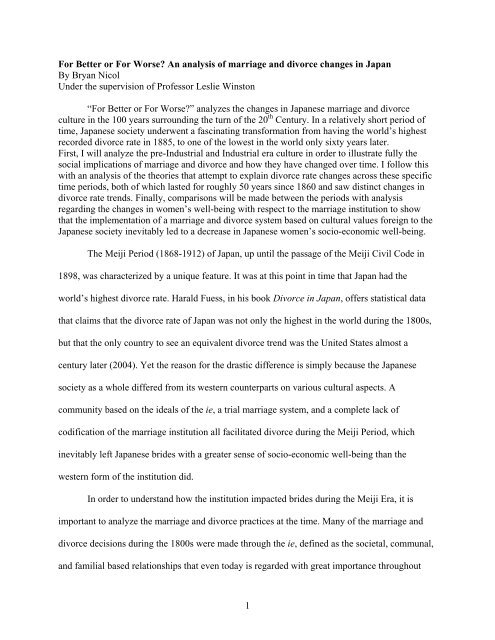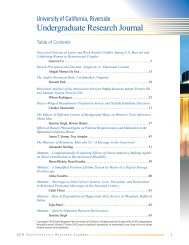For Better or For Worse? An analysis of marriage and divorce ...
For Better or For Worse? An analysis of marriage and divorce ...
For Better or For Worse? An analysis of marriage and divorce ...
You also want an ePaper? Increase the reach of your titles
YUMPU automatically turns print PDFs into web optimized ePapers that Google loves.
<strong>F<strong>or</strong></strong> <strong>Better</strong> <strong>or</strong> <strong>F<strong>or</strong></strong> W<strong>or</strong>se? <strong>An</strong> <strong>analysis</strong> <strong>of</strong> <strong>marriage</strong> <strong>and</strong> div<strong>or</strong>ce changes in JapanBy Bryan NicolUnder the supervision <strong>of</strong> Pr<strong>of</strong>ess<strong>or</strong> Leslie Winston“<strong>F<strong>or</strong></strong> <strong>Better</strong> <strong>or</strong> <strong>F<strong>or</strong></strong> W<strong>or</strong>se?” analyzes the changes in Japanese <strong>marriage</strong> <strong>and</strong> div<strong>or</strong>ceculture in the 100 years surrounding the turn <strong>of</strong> the 20 th Century. In a relatively sh<strong>or</strong>t period <strong>of</strong>time, Japanese society underwent a fascinating transf<strong>or</strong>mation from having the w<strong>or</strong>ld’s highestrec<strong>or</strong>ded div<strong>or</strong>ce rate in 1885, to one <strong>of</strong> the lowest in the w<strong>or</strong>ld only sixty years later.First, I will analyze the pre-Industrial <strong>and</strong> Industrial era culture in <strong>or</strong>der to illustrate fully thesocial implications <strong>of</strong> <strong>marriage</strong> <strong>and</strong> div<strong>or</strong>ce <strong>and</strong> how they have changed over time. I follow thiswith an <strong>analysis</strong> <strong>of</strong> the the<strong>or</strong>ies that attempt to explain div<strong>or</strong>ce rate changes across these specifictime periods, both <strong>of</strong> which lasted f<strong>or</strong> roughly 50 years since 1860 <strong>and</strong> saw distinct changes indiv<strong>or</strong>ce rate trends. Finally, comparisons will be made between the periods with <strong>analysis</strong>regarding the changes in women’s well-being with respect to the <strong>marriage</strong> institution to showthat the implementation <strong>of</strong> a <strong>marriage</strong> <strong>and</strong> div<strong>or</strong>ce system based on cultural values f<strong>or</strong>eign to theJapanese society inevitably led to a decrease in Japanese women’s socio-economic well-being.The Meiji Period (1868-1912) <strong>of</strong> Japan, up until the passage <strong>of</strong> the Meiji Civil Code in1898, was characterized by a unique feature. It was at this point in time that Japan had thew<strong>or</strong>ld’s highest div<strong>or</strong>ce rate. Harald Fuess, in his book Div<strong>or</strong>ce in Japan, <strong>of</strong>fers statistical datathat claims that the div<strong>or</strong>ce rate <strong>of</strong> Japan was not only the highest in the w<strong>or</strong>ld during the 1800s,but that the only country to see an equivalent div<strong>or</strong>ce trend was the United States almost acentury later (2004). Yet the reason f<strong>or</strong> the drastic difference is simply because the Japanesesociety as a whole differed from its western counterparts on various cultural aspects. Acommunity based on the ideals <strong>of</strong> the ie, a trial <strong>marriage</strong> system, <strong>and</strong> a complete lack <strong>of</strong>codification <strong>of</strong> the <strong>marriage</strong> institution all facilitated div<strong>or</strong>ce during the Meiji Period, whichinevitably left Japanese brides with a greater sense <strong>of</strong> socio-economic well-being than thewestern f<strong>or</strong>m <strong>of</strong> the institution did.In <strong>or</strong>der to underst<strong>and</strong> how the institution impacted brides during the Meiji Era, it isimp<strong>or</strong>tant to analyze the <strong>marriage</strong> <strong>and</strong> div<strong>or</strong>ce practices at the time. Many <strong>of</strong> the <strong>marriage</strong> <strong>and</strong>div<strong>or</strong>ce decisions during the 1800s were made through the ie, defined as the societal, communal,<strong>and</strong> familial based relationships that even today is regarded with great imp<strong>or</strong>tance throughout1
equired by families would have much the same effect, as the number <strong>of</strong> <strong>marriage</strong>s recognized bylegal st<strong>and</strong>ards clearly would differ from those recognized purely by social st<strong>and</strong>ards.The first possibility listed above is perhaps m<strong>or</strong>e likely to explain the general downwardtrend in div<strong>or</strong>ce rates that took place over the following fifty years. The scholars in Meiji Japanwho had heavily critiqued the society f<strong>or</strong> its high div<strong>or</strong>ce rates had also been calling f<strong>or</strong> aref<strong>or</strong>mation <strong>of</strong> the <strong>marriage</strong> ceremony, saying that the ease with which one could marry <strong>and</strong>div<strong>or</strong>ce detracted from the significance <strong>of</strong> the institution itself (Fuess 2004). A completerenovation in the <strong>marriage</strong> ceremony began to take place. Scholars, <strong>and</strong> even the government,now wanted the ceremony to reflect religious principles <strong>and</strong> the resulting ceremony became agr<strong>and</strong>iose affair that would inc<strong>or</strong>p<strong>or</strong>ate heavy influences from its Christian counterparts (Fuess2004). Fuess quotes various scholars who comment on the elab<strong>or</strong>ateness <strong>of</strong> the affair, saying thatpreviously one could marry f<strong>or</strong> a mere five yen, while after the transf<strong>or</strong>mation <strong>marriage</strong>s sawnearly unbelievable cost increases (Fuess 2004).Interestingly, many argue that it was the increase in the overall cost <strong>of</strong> the <strong>marriage</strong>ceremony, rather than the religious principles within the ceremony itself, that would eventuallylead to a decrease in the overall rate <strong>of</strong> div<strong>or</strong>ce. Especially in rural society, Fuess contends, theeconomic cost <strong>of</strong> the <strong>marriage</strong> ceremony had a direct impact on how willing the spouses were todiv<strong>or</strong>ce within the first few years <strong>of</strong> <strong>marriage</strong>, reflected in the increased average length <strong>of</strong> time in<strong>marriage</strong>s bef<strong>or</strong>e div<strong>or</strong>ce (Fuess 2004).This has some interesting implications. Since the <strong>marriage</strong> culture in Japan was one thatheavily relied on arranged <strong>marriage</strong>, the western style <strong>of</strong> dating was still considered to be absentfrom Japanese society at this time. Even if the arranged <strong>marriage</strong> could be considered a8
mismatch, <strong>and</strong> this was realized fairly early on in the <strong>marriage</strong>, spouses were still less willing todiv<strong>or</strong>ce because <strong>of</strong> the sheer cost <strong>of</strong> the celebration.Furtherm<strong>or</strong>e, the larger scale <strong>of</strong> the <strong>marriage</strong> ceremony implies that there was no longerany ambiguity regarding whether a couple was considered married—the immediate communitywould know when a <strong>marriage</strong> occurred. With the addition <strong>of</strong> the Japanese media’s critical <strong>and</strong>negative response to their country’s high rate <strong>of</strong> div<strong>or</strong>ce, a couple saw a drastic increase in socialopp<strong>or</strong>tunity costs <strong>of</strong> seeking a div<strong>or</strong>ce due to an increase in social stigma against div<strong>or</strong>cepractices (Fuess 2004). Terry Trucco writes that the general response to a div<strong>or</strong>ced womanbecame increasingly stigmatized in pre-war periods. “The adulteress was dead to society, but thediv<strong>or</strong>ced woman was considered even w<strong>or</strong>se … She had failed as a wife, the one role a Japanesewoman is expected to fulfill” (Trucco 1982). This is a stark contrast from the near nonexistentstigma present during the Meiji Era. Whereas previously Japanese women could enter into <strong>and</strong>leave unions several times with no social consequences, brides <strong>of</strong> the early 20 th Century could beremoved completely from the <strong>marriage</strong> market after one single div<strong>or</strong>ce not only harming theirsocial well-being, but their future economic prospects as well.This places an interesting spin on the debate between women’s well being <strong>and</strong> their socialstatus in the Japanese society in terms <strong>of</strong> div<strong>or</strong>ce. Given the above discussion it seems clear thateven though men <strong>and</strong> women had the equal opp<strong>or</strong>tunity to div<strong>or</strong>ce, <strong>and</strong> thus had also achievedequal social status in terms <strong>of</strong> their ability to dissolve the institution itself, the socio-economicwell-being <strong>of</strong> a div<strong>or</strong>cing couple would be considerably less in comparison to those whodiv<strong>or</strong>ced bef<strong>or</strong>e the passage <strong>of</strong> the Meiji Civil Code. The fact that women’s social status hadrisen from her equal ability in obtaining a div<strong>or</strong>ce became completely immaterial in the face <strong>of</strong>the increase in the economic <strong>and</strong> social pressures <strong>of</strong> <strong>marriage</strong>.9
There is, however, a second the<strong>or</strong>y that seeks to examine the declination in the div<strong>or</strong>cerate immediately following the turn <strong>of</strong> the century. Takeyoshi Kawashima <strong>and</strong> Kurt Steiner intheir article “Modernization <strong>and</strong> Div<strong>or</strong>ce Rate Trends in Japan,” attribute the increase inindustrialization to the decrease in div<strong>or</strong>ce rates by the comparison <strong>of</strong> the affects <strong>of</strong>industrialization in western societies. Their argument is as follows: In Judeo-Christian basedwestern societies <strong>and</strong> in Japan as well, industrialization leads to an increase in the imp<strong>or</strong>tance <strong>of</strong>the individual. In western societies, in which <strong>marriage</strong> is characterized by the sanctity <strong>of</strong> therelationship between two spouses, industrialization will inevitably lead to an increase in theamount <strong>of</strong> div<strong>or</strong>ce due to an increase on the imp<strong>or</strong>tance <strong>of</strong> the individual. On the other h<strong>and</strong>,Japanese society is a heavily community <strong>and</strong> lineage based society. In this case, Japaneseindividuals will also experience a rise in self-imp<strong>or</strong>tance, but instead this rise will manifest itselfin weakened ties to the ie system <strong>and</strong> an increase in the conjugal ties between spouses, inevitablyleading to a decease in the div<strong>or</strong>ce rate. Furtherm<strong>or</strong>e, Kawashima <strong>and</strong> Steiner claim that while itcannot be denied that the local economy will have some s<strong>or</strong>t <strong>of</strong> impact on div<strong>or</strong>ce in a given area,they contend that there is no direct c<strong>or</strong>relation between the two, especially in the later stages <strong>of</strong>industrialization (Kawashima <strong>and</strong> Steiner 1960).When compared to Fuess’s, Kawashima <strong>and</strong> Steiner’s arguments seem to be oppositesides <strong>of</strong> the same coin. Kawashima <strong>and</strong> Steiner argue that the lengthening <strong>of</strong> <strong>marriage</strong> bef<strong>or</strong>ediv<strong>or</strong>ce reflects the strengthening <strong>of</strong> the individual in contention with the ie system caused by thechange in the national economy by means <strong>of</strong> industrialization seen in the early 1900s. Fuess, onthe other h<strong>and</strong>, contends that it was the economics on an individual level that immediatelycaused the lengthening <strong>of</strong> <strong>marriage</strong> bef<strong>or</strong>e div<strong>or</strong>ce, while social influences on the aggregate levelled to a change in the <strong>marriage</strong> ceremony itself. Both arguments together would imply that both10
social <strong>and</strong> economic pressure on both the individual <strong>and</strong> societal level led to a complete changein the way the institutions <strong>of</strong> <strong>marriage</strong> <strong>and</strong> div<strong>or</strong>ce functioned in Japan.At the same time, however, an imp<strong>or</strong>tant question must be raised in light <strong>of</strong> both <strong>of</strong> thesearguments: In the early 1900s in Japan, were couples div<strong>or</strong>cing less frequently because they weregenerally in happier <strong>marriage</strong>s, <strong>or</strong> was div<strong>or</strong>ce less likely because <strong>of</strong> the increase in economic<strong>and</strong> social opp<strong>or</strong>tunity costs? If the actual cause can be attributed to an increase in the generalhappiness <strong>of</strong> unions, then both women’s social status <strong>and</strong> general well-being would seem to haveincreased since the passage <strong>of</strong> the Meiji Civil Code. On the other h<strong>and</strong>, if the latter alternative isthe case, then assuming that the general happiness in <strong>marriage</strong>s remained equal both bef<strong>or</strong>e <strong>and</strong>after the passage <strong>of</strong> the Code, a woman’s social status would have increased with her ability inlegally procuring a div<strong>or</strong>ce while her socio-economic well-being would have diminished due tothe increase in economic <strong>and</strong> social opp<strong>or</strong>tunity costs associated with the dissolution <strong>of</strong> a<strong>marriage</strong>.In either case, women who desired to procure a div<strong>or</strong>ce during Japan’s Industrial erainevitably saw an increase in the social <strong>and</strong> economical opp<strong>or</strong>tunity costs f<strong>or</strong> doing so, whichfurther restricted opp<strong>or</strong>tunities f<strong>or</strong> the dissolution <strong>of</strong> mismatched <strong>marriage</strong>s. Thus, while f<strong>or</strong>eignscholars were focusing so heavily on their fight to create “equality” f<strong>or</strong> Japanese women in terms<strong>of</strong> the law, they did not consider that the ramifications <strong>of</strong> the implementation <strong>of</strong> a f<strong>or</strong>eign valuesystem <strong>of</strong> <strong>marriage</strong> <strong>and</strong> div<strong>or</strong>ce into Japan’s highly active div<strong>or</strong>ce culture. Women who foundthemselves in unhappy <strong>marriage</strong>s were now faced with two options: to suffer through therelationship <strong>or</strong>, as Trucco writes, to be w<strong>or</strong>se than “dead to society.” Thus, the Meiji Code, thef<strong>or</strong>eign scholars, <strong>and</strong> the government had failed Japanese women completely, creating a zerosumgame f<strong>or</strong> those who, bef<strong>or</strong>e 1898, could have div<strong>or</strong>ced <strong>and</strong> entered into a new relationship11
with ease, maintaining a greater level <strong>of</strong> social <strong>and</strong> economic security than after the drasticsocietal transf<strong>or</strong>mations that took place at the turn <strong>of</strong> the century.Fig I. (Fuess 2004, fig. I)W<strong>or</strong>ks CitedC<strong>or</strong>nell, Laurel L. 1990. "Peasant Women <strong>and</strong> Div<strong>or</strong>ce in Preindustrial Japan." Pp. 710-732 inSigns vol. 15Fuess, Harald. 2004. Div<strong>or</strong>ce in Japan. Stanf<strong>or</strong>d: Stanf<strong>or</strong>d UP.Hendry, Joy. 1981. Marriage in Changing Japan. London: Croom Helm London.Kawashima, Takeyoshi, <strong>and</strong> Kurt Steiner. 1960. "Modernization <strong>and</strong> Div<strong>or</strong>ce Rate Trends inJapan." Pp 213-239 in Economic Development <strong>and</strong> Cultural Change.Long, Susan O. 1987. Family Change <strong>and</strong> the Life Course in Japan. Ithaca: East Asia Program.Trucco, Terry. 1982. “Women’s Views on Div<strong>or</strong>ce are Changing in Japan.” New Y<strong>or</strong>k Times,June 11, Late ed., p. B8.Yoshida, Ritsuko. 1990. “Getting Married the C<strong>or</strong>p<strong>or</strong>ate Way.” Pp. 171-175 in Japan Quarterly.vol. 37:212














